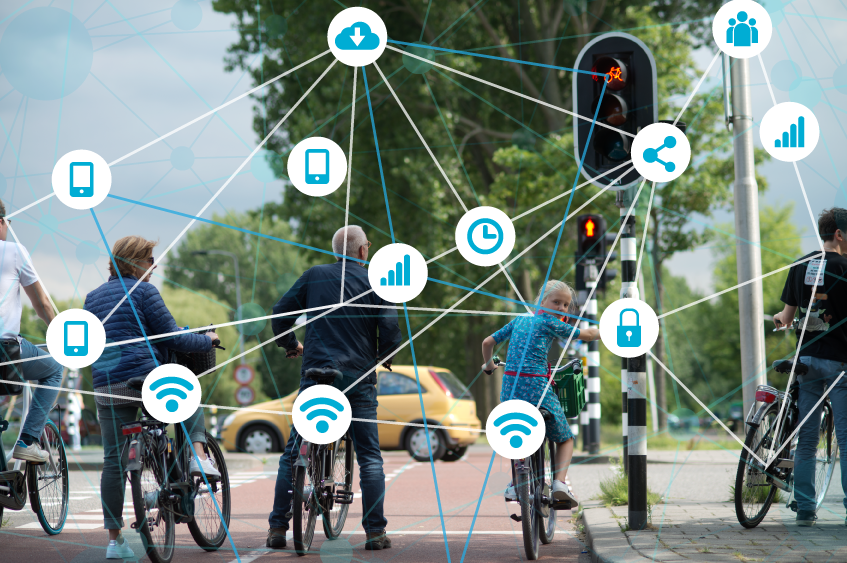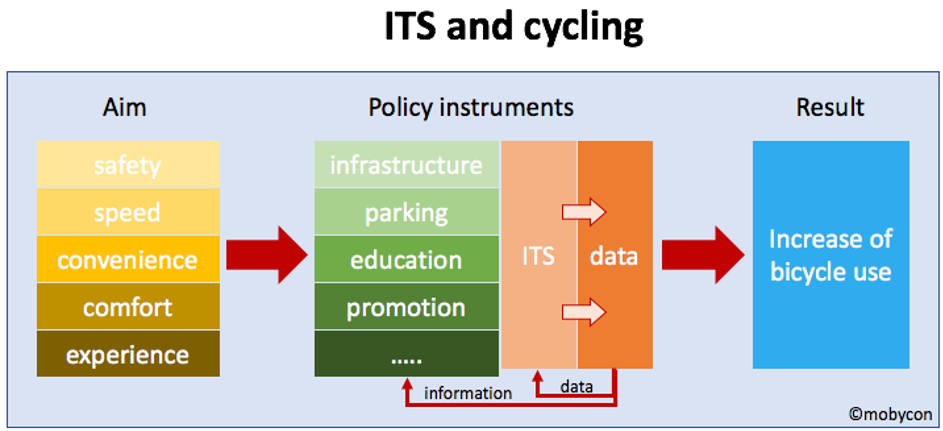BITS / Cycling / Innovation / Innovative / ITS / Mobility management / Research / Technology / Traffic safety
Bicycles and ITS: Making cycling smarter

The following article was originally published in Dutch for verkeerskunde.nl HERE.
The mobility sector is full of ICT-developments that are having a major impact on how we travel and how we use our public spaces. While these developments, often referred to as ‘Intelligent Transport Systems’ (ITS), receive a lot of attention when it comes to motorized transport, this is certainly not the case for ITS applications in cycling. Given the fact that cycling, as a healthy and sustainable mode of transport, is being increasingly promoted, we should ask ourselves what role ITS could play in promoting cycling.
Valid questions are: can ITS make a cyclist ride faster and easier? And is artificial intelligence a possible solution in making cycling safer? Also: should bicycles become as ‘connected’ as cars or is simplicity one of the bike’s most valuable assets and should we keep it that way?
It is not that there are no developments in this area. In fact, few weeks pass without new ITS applications in cycling. In the city of Utrecht alone we see shared bicycles with smart locks, bicycle parking guidance systems, intelligent traffic lights and bicycles with devices that monitor air quality. These are just the examples that we can actually see; behind the scenes all kinds of cycling data are being collected and analysed.
Increasingly, businesses are developing ITS applications for cycling, from start-ups to established names. At Mobycon, we developed the concept of “Pool-to-pool bike sharing” to reduce parking pressure at stations. Our smart cameras are also being used to accurately register traffic (vehicle type, direction, speed) in complex traffic situations and with the help of AI powered software, (near) collisions can be identified and categorized in risk classes.
All kinds of ITS applications have the potential to make cycling safer, more convenient and more attractive. At the same time, we have to conclude that the exact possibilities are to a large extent unclear. The knowledge does exist but is fragmented and very context-specific.
Nevertheless, we are convinced that ITS could have a large positive effect on cycling and that ITS certainly deserves a place in the bicycle-toolkit, just like the ‘traditional’ measures like infrastructure, bicycle parking, education and promotion. An additional benefit of using ITS applications in cycling is that they often generate valuable data that can be used to gain new insights and improve policies, as visualised in this image.

Doing so, requires a better understanding of the possibilities of ITS and to effectively implement ITS. Within the BITS (Bicycles and Intelligent Transport Systems) project, we are currently creating the necessary knowledge and experience by implementing 23 ITS applications for cycling in five countries. In this Interreg NSR funded project, together with cities, regions, universities and other organizations from five countries, we are exploring how ITS can make cycling safer, more comfortable and more attractive.
On the one hand, we are realising ITS applications that directly affect the cyclist, such as smart traffic lights, parking guidance systems and gamification and tracking apps, and on the other hand we are investing in data applications that indirectly influence cycling. Data is being used both as input for ITS applications as well as to evaluate and improve policies. This gives us insights in the effectiveness of applications and the preconditions that apply. In the BITS project, we will increase the availability of bicycle data by creating the so-called CycleDataHub; an open data portal where people can share and access bicycle data.
At Mobycon, we are using our experience with BITS and other projects in the field of ITS and cycling to help governments and organizations that want to enhance cycling conditions with ITS. We believe ITS should never be the goal, but a means for effective mobility policies, just like any other intervention. Technology has the potential to improve our mobility system and our living environment, but only when applied correctly and in the right situation. Data can be highly valuable, but only when properly being dealt with.
This does not only require governments to take charge, but it also requires knowledge to answer questions like: Could ITS actually contribute to my goals? Which application would be the most (cost-)effective? What should be taken care of to ensure that people will actually use the solution? How do you measure effects and how can you make necessary adjustments? But also: What else can you get from your cycling data and how do you ensure proper data management?
 These and other question will be answered by mobility advisors Ronald Jorna and Robin Kleine in an upcoming series of articles on ITS and cycling that will be published in verkeerskunde.nl and translated on our website throughout the year.
These and other question will be answered by mobility advisors Ronald Jorna and Robin Kleine in an upcoming series of articles on ITS and cycling that will be published in verkeerskunde.nl and translated on our website throughout the year.


 ">
">